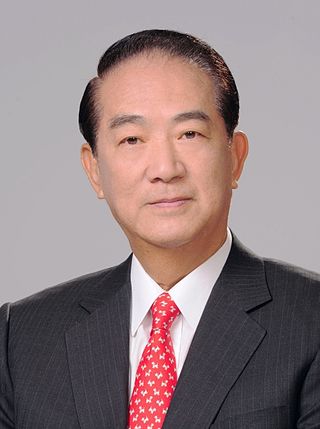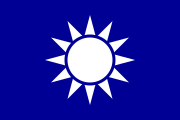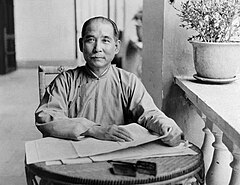
Taiwan, officially the Republic of China (ROC), is governed in a framework of a representative democratic republic under a five-power system first envisioned by Sun Yat-sen in 1906, whereby under the constitutional amendments, the President is head of state and the Premier is head of government, and of a multi-party system. Executive power is exercised by the Executive Yuan. Legislative power is vested primarily in the Legislative Yuan. The judiciary is independent of the executive and the legislature. In addition, the Examination Yuan is in charge of validating the qualification of civil servants, and the Control Yuan inspects, reviews, and audits the policies and operations of the government.

Chen Shui-bian is a Taiwanese former politician and lawyer who served as the 5th president of the Republic of China (Taiwan) from 2000 to 2008. Chen was the first president from the Democratic Progressive Party (DPP) which ended the Kuomintang's (KMT) 55 years of continuous rule in Taiwan. He is sometimes referred to by the nickname A-Bian (阿扁).

The People First Party is a centrist or centre-right political party in Taiwan.

James Soong Chu-yu is a Taiwanese politician who is the founder and current Chairman of the People First Party. Soong was the first and only elected Governor of Taiwan Province from 1994 and 1998. He was a candidate in the 2000 presidential election, which he lost to Chen Shui-bian of the Democratic Progressive Party (DPP).

Presidential elections were held in Taiwan on 18 March 2000 to elect the president and vice president. With a voter turnout of 83%, Chen Shui-bian and Annette Lu of the Democratic Progressive Party (DPP) were elected president and vice president respectively with a slight plurality.

Presidential elections were held in Taiwan on 20 March 2004. A consultative referendum took place on the same day regarding relations with the People's Republic of China.

Hsu Hsin-liang is a Taiwanese politician, formerly Chairman of the Democratic Progressive Party (DPP). He was a supporter of the Pan-Blue Coalition from 2000 to 2008 but then supported the DPP in the 2008 presidential election.

Wang Jin-pyng is a Taiwanese politician. He served as President of the Legislative Yuan from 1999 to 2016, which makes him Taiwan's longest-serving legislative speaker. Once a leading figure of the Kuomintang (KMT), Wang is considered to be soft-spoken and a conciliatory figure who has often brokered deals between the KMT and opposition DPP. Due to his longevity, experience and influence in political scene, he is a widely respected figure in Taiwanese politics. He was replaced by Democratic Progressive Party's Su Jia-chyuan as President of the Legislative Yuan after a decisive victory for the DPP in the 2016 election.

The 2004 Taiwanese legislative election was held on 11 December 2004. All 225 seats of the Legislative Yuan were up for election: 168 elected by single non-transferable vote, 41 elected through party-list Proportional representation, eight elected from overseas Chinese constituencies on the basis of the proportion of nationwide votes received by participating political parties, eight elected by popular vote among the aboriginal populations. Members served three-year terms beginning on 1 February 2005, and ending 31 January 2008. The next term served four years.

This is a timeline of the Republic of China.

The 2001 Taiwanese legislative election was held on 1 December 2001. All 225 seats of the Legislative Yuan were up for election: 168 elected by popular vote, 41 elected on the basis of the proportional representation based of the nationwide votes received by participating political parties, eight elected from overseas Chinese constituencies on the basis of the proportion of nationwide votes received by participating political parties, eight elected by popular vote among the Taiwanese aboriginal populations. Members served three year terms from February 1, 2002 to February 1, 2005.

The 2005 Pan–Blue visits to mainland China were a series of groundbreaking visits by delegations of the Kuomintang (KMT) and their allied Pan-Blue Coalition to mainland China. They were hailed as the highest level of exchange between the Chinese Communist Party and the Kuomintang since Chiang Kai-shek and Mao Zedong met in Chongqing, China on August 28, 1945.

An election for the National Assembly took place in Taiwan on Saturday, 14 May 2005, from 07:30 to 16:00 local time. It elected an ad hoc National Assembly whose only function was to serve as a constituent assembly in order to approve or reject amendments to the Constitution of the Republic of China already proposed by the Legislative Yuan. The results indicated that the amendments would be approved, as the parties supporting them won an overwhelming majority, and indeed the amendments were passed on 7 June 2005.
The 2005 Kuomintang chairmanship election was held on July 16, 2005 in Taiwan between Ma Ying-jeou and Wang Jin-pyng. The election was triggered by the retirement of chairman Lien Chan.

Presidential elections were held in Taiwan on 22 March 2008. Kuomintang (KMT) nominee Ma Ying-jeou won with 58% of the vote, ending eight years of Democratic Progressive Party (DPP) rule. Along with the 2008 legislative election, Ma's landslide victory brought the Kuomintang back to power in the Republic of China.

Local elections were held in Taiwan on 3 December 2005 to elect magistrates of counties and mayors of cities, councillors in county/city councils and mayors of townships and cities, known as the three-in-one elections, on 10 June 2006 to elect representatives in township/city councils and village chiefs, on 9 December 2006 to elect mayors and councillors of special municipalities, and on 30 December 2006 to elect village chiefs in Taipei City.

Legislative elections were held in Taiwan on 12 January 2008 to elect the members of the Legislative Yuan. It was the first Legislative Yuan election after the constitutional amendments of 2005, which extended term length from three to four years, reduced seat count from 225 to 113, and introduced the current electoral system.

Presidential elections were held in Taiwan on 14 January 2012. The election was held concurrently with legislative elections. It was the fifth direct election for the President of the Republic of China. Prior to 1996, the President was elected by the ROC's National Assembly and not directly by the people.
Chang Sho-wen is a Taiwanese politician. He first won election to the Legislative Yuan in 2004 and was reelected in 2008. Partway through his second term, Chang was removed from office on charges of electoral fraud. He left the Kuomintang in 2015 and joined the People First Party.
Chen Horng-chi is a Taiwanese politician who served as a member National Assembly between 1992 and 1996, when he was seated to the Legislative Yuan. Shortly after stepping down from the legislature in 2002, Chen left the Kuomintang and joined the Taiwan Solidarity Union.




















